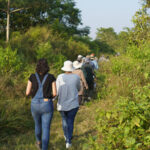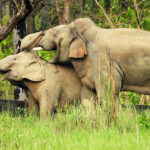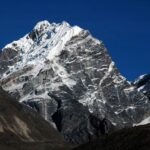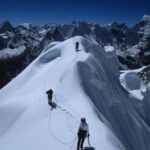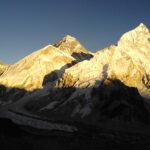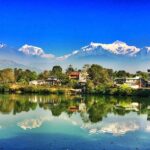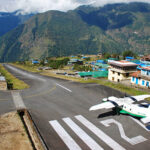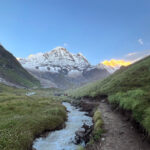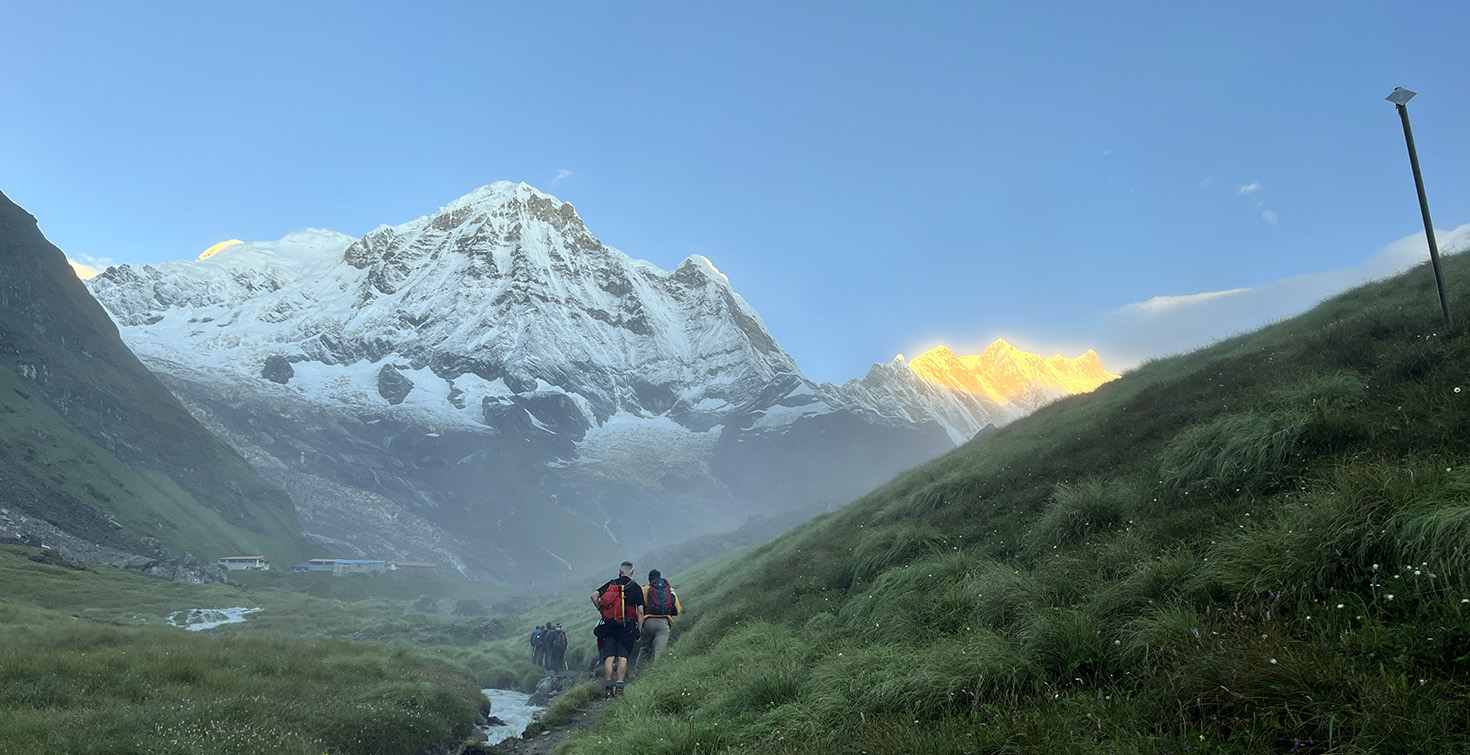
Best time for Annapurna Base Camp Trek
Best Time for Annapurna Base Camp Trek is during spring and autumn, offering clear skies, moderate temperatures, and vibrant landscapes. The Annapurna Base Camp (ABC) trek stands as one of the most coveted Himalayan journeys in Nepal, alluring countless trekkers each year. Offering awe-inspiring vistas of majestic peaks, including Annapurna, this expedition promises an unforgettable trekking adventure.
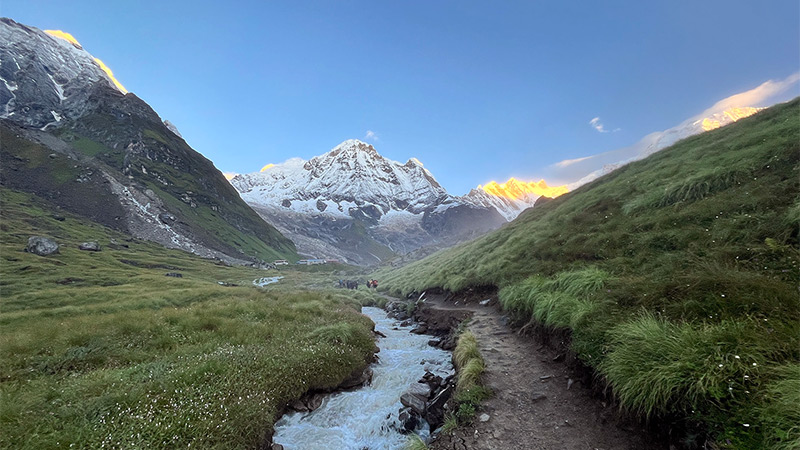
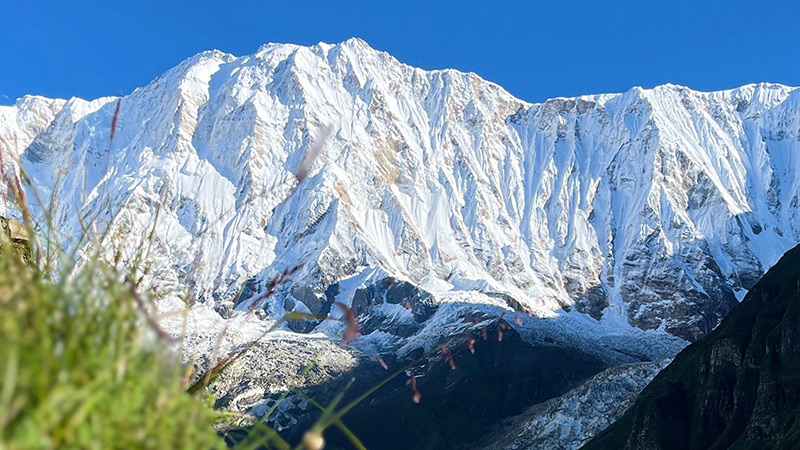
While the Annapurna Base Camp trek is feasible year-round, the ideal time for this adventure hinges on a variety of factors, from climate conditions to trail stability and tourist volumes. The autumn and spring seasons emerge as the prime windows. During these periods, the weather remains dry and consistent, delivering clear skies and daytime temperatures ranging from 15-25°C.
Autumn takes the crown as the busiest season for ABC trekking, followed closely by the spring season, both attracting global trekkers in substantial numbers. Winter (December to February) also holds promise, albeit with chilly weather and the potential for snowfall. Yet, it offers the perk of a less crowded trail, providing a tranquil and quieter trekking experience.
In stark contrast, the monsoon season (June to August) is unequivocally unfavorable for trekking. The trails become mired in mud, prone to slipperiness and landslides. Rainfall makes walking arduous, clouds cloak the skies, and weather fluctuations are unpredictable, categorizing this period as the off-season for ABC trekking.
In summary, the spring and autumn months reign supreme for the Annapurna Base Camp trek. Venturing forth during winter is feasible with adequate preparation, while monsoon months should be avoided. For a gratifying trekking experience, your best choices are spring and autumn.
“To walk in nature is to witness a thousand miracles.”
By Mary Davis
Table of Contents
- Annapurna base camp trekking in Spring Season
- Annapurna base camp trekking in Summer Season
- Annapurna base camp trekking in Autumn Season
- Annapurna base camp trekking in Winter Season
Annapurna base camp trekking in Spring Season (March/April/May)
Embarking on the journey to Annapurna Base Camp during the spring season, spanning from March to June, promises an unparalleled adventure amidst the heart of the Nepalese Himalayas. Spring is widely acclaimed as the prime time for the Annapurna Base Camp Trek, and the rationale behind this acclaim is quite compelling.
During spring, the weather in the Annapurna region is at its most favorable. Days bestow trekkers with a comfortable warmth, permitting them to relish the breathtaking landscapes without grappling with the biting cold. However, it’s prudent to be prepared for the chilly nights, as temperatures can plummet to as low as -8 degrees Celsius.
One of the most enchanting facets of spring trekking is the landscape’s vibrant transformation. Verdant forests awaken with life, and the trail is adorned with the vivid splendor of rhododendron and magnolia blossoms. The forested path evolves into a canvas of colors, treating trekkers to a visual spectacle. Yet, due to its immense popularity, the trail can become quite crowded during this season. Therefore, prudent planning and advance accommodations booking are advisable.
As spring unfolds, the snow begins to melt, and the weather turns gentler and more predictable. This makes it the perfect time for the Annapurna Base Camp trek, devoid of concerns about sudden snowfall or extreme cold spells. It’s crucial to pack appropriate clothing and gear, including layers to stay warm during the chilly nights and sun protection for the daytime. One of the pinnacles of this trek is the enchanting sunrise views from the Annapurna Base Camp itself. As the sun’s first rays grace the snow-cloaked peaks, the entire panorama bathes in a warm, golden glow. The experience is nothing short of breathtaking and remains etched in trekkers’ memories.
Furthermore, traversing the region during this season allows you to relish the melodious tunes of countless birds and the mesmerizing sight of innumerable butterflies fluttering along your path. This adds an exquisite layer to the trek, transforming it into not just a physical challenge but also a sensory odyssey through nature.
One of the most significant perks of spring trekking is that the temperature strikes a harmonious balance, neither excessively hot nor bitingly cold. The stable, dry weather minimizes precipitation, ensuring non-slippery trails, and rendering the trek safer and more enjoyable.
In sum, trekking to Annapurna Base Camp in the spring season is an unforgettable adventure where you’ll witness nature’s finest beauty and savor the grandeur of the Himalayas in all their resplendent glory.
Annapurna base camp in Summer Season (June/July/August)
Embarking on the Annapurna Base Camp trek in Nepal during the summer and monsoon season, which runs from July to mid-September, offers a unique and thrilling adventure. During this period, there is a notable change in weather as the country transitions from spring to summer and enters the monsoon season. The Annapurna Region experiences daytime temperatures ranging from 20 to 25 degrees Celsius, providing a pleasant and warm environment for trekking.
However, the nights can become chilly, with temperatures dropping to approximately -1 to -2 degrees Celsius. This requires making preparations for colder weather. The Annapurna Base Camp area experiences a monsoon season that brings about a distinct set of challenges, one of which is the presence of leeches, known for being particularly troublesome. In order to avoid leech bites, trekkers must remain vigilant and take protective measures, as these creatures thrive in humid and wet conditions.
In order to protect themselves from leeches and be prepared for the unpredictable weather, trekkers should make sure to pack full-length clothing, anti-slip boots, and high-quality rain jackets and pants. This is especially important as the rain can be both intense and frequent. Carrying a wide-brimmed hat serves two purposes: it protects from the sun’s rays and also keeps the face dry and comfortable during a trek, even in the rain. In addition, it is important to note that the monsoon season can sometimes cause landslides along certain sections of the ABC trekking routes. This means that travelers must be adaptable and flexible in order to effectively handle any potential disruptions that may arise.
One remarkable aspect of trekking during the monsoon season is the breathtaking mountain vistas that follow the rain. After the rain stops and the skies become clear, the Annapurna range offers awe-inspiring views. The landscape is adorned with lush greenery, glistening raindrops adding to its unique allure. The air feels revitalizing and pure. Those who choose to embrace the monsoon experience as trekkers are rewarded with captivating and pristine scenery that is unlike anything they would see during any other time of the year.
During the monsoon season, the Annapurna Base Camp trails experience less congestion, making it an ideal choice for those seeking tranquility and solitude.
However, it is crucial to remain aware of possible flight disruptions that may occur during the monsoon season in Nepal. Heavy rains and low visibility can cause disruptions to domestic flights in the trekking regions, which can be challenging for travelers, especially those with tight schedules or connecting flights. It is advisable to allocate extra time in your travel plans to accommodate possible delays.
Embarking on a trek to the Annapurna Base Camp during the summer and monsoon season provides a unique and exciting adventure, allowing you to gain a fresh perspective on the breathtaking region.
Although the journey to ABC poses certain challenges, such as encountering leeches and the risk of landslides, it also offers the chance to witness the breathtaking beauty of the Himalayas after the monsoon season. Those who are well-prepared, adaptable, and willing to embrace the elements will find this trek to be an enriching and memorable experience.
Annapurna base camp trekking in Autumn Season (September/October/November)
After the cold and somber winter months, the vibrant spring season arrives, spanning from March to May. This season presents an excellent opportunity to embark on the Annapurna Base Camp trek. Spring in Nepal showcases its breathtaking beauty from the months of March to May.
Spring offers trekkers delightful weather, perfectly blending warmth and coolness, making it an ideal time for trekking. During the spring season, the average daytime temperature typically ranges from 16 to 22 degrees Celsius (61 to 68 degrees Fahrenheit), providing pleasant and comfortable days. During the night, a mild chill may be felt, as temperatures can drop to as low as 2 or 3 degrees Celsius (27 or 28 degrees Fahrenheit).
The skies in spring are exceptionally clear, providing uninterrupted views of the magnificent Himalayan ranges. While there’s a slight possibility of rainfall during this season, it tends to be brief. It is wise to bring a lightweight raincoat with you for your spring trek to Annapurna Base Camp. Occasionally, a faint haze might veil the mountain panoramas.
During spring, trekkers are treated to a vibrant tapestry of colors as they traverse the trails adorned with the beautiful blossoms of rhododendrons and a variety of wildflowers. The scenery is incredibly picturesque, with the vibrant colors of red, yellow, pink, and white rhododendron blooms adding to the trail’s appeal.
However, due to the favorable conditions, the Annapurna Base Camp Trek attracts a significant number of fellow trekkers, making it inevitable to encounter them. During the spring season, individuals from various parts of the world and different cultural backgrounds come together on these trails. If you enjoy socializing and the companionship of other hikers, you will find this time to be especially enjoyable. However, if you are seeking solitude while trekking, it may be slightly challenging during this busy season.
Annapurna base camp in Winter Season (December/January/February)
Undoubtedly, choosing to embark on the Annapurna Base Camp trek during the winter season, which spans from December through February, is a daring and challenging option for those determined to conquer this iconic trail. During the winter season, the ABC trek undergoes a transformation, becoming an odyssey characterized by harsh weather and a landscape covered in a beautiful, untouched layer of snow.
One significant advantage of winter trekking is the noticeable decrease in the number of fellow trekkers. The solitude experienced amidst the breathtaking beauty of the Himalayas can be an incredibly rewarding aspect of the journey. The Annapurna region poses a significant challenge due to its harsh winter temperatures. During the day, the temperature ranges from a bone-chilling 0 to 5 degrees Celsius, and drops even further to a frigid -10 to -15 degrees Celsius at night. Dealing with this intense cold becomes a top priority.
Winter trekking is inherently risky due to the heavy blanket of snow that buries the trails and the increased danger of avalanches. It is important to recognize that it is not advisable for novice or inexperienced hikers to venture to the ABC during winter. Despite the challenges, the winter season brings a distinct and enchanting beauty to the landscape. It undergoes a remarkable transformation, becoming a pristine wonderland adorned with breathtaking glaciers, snow-covered peaks, and the opportunity to witness cold-adapted wildlife and flora.
In order to navigate through these challenging conditions, trekkers require durable and warm clothing, such as insulating woolen coats. It is important to recognize that hiking trails can sometimes become blocked due to heavy snowfall and the constant risk of avalanches. As a result, traveling can become difficult and dangerous for hikers. Therefore, it is essential to conduct a comprehensive assessment of the challenges and potential risks before embarking on the Annapurna Base Camp trek in winter.
In addition, it is crucial to stay well-hydrated in order to maintain proper bodily function in cold weather. It is also important to exercise extreme caution to avoid slipping and the potential for serious injuries.
Trekking to the Annapurna Base Camp during the winter season is a challenging endeavor that requires courage and determination. The trek presents a challenging and adventurous journey that is most suitable for experienced hikers who are thoroughly prepared for the unpredictable weather conditions and potential hazards that may arise along the way.
Although the winter landscape is undeniably beautiful and captivating, it is crucial to prioritize safety and be fully aware of the challenges and risks associated with this season.

